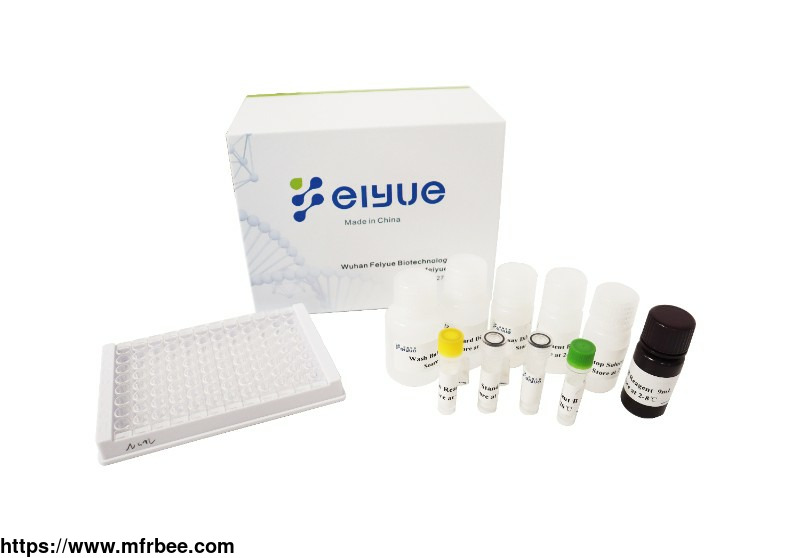FY-ER3503 Rat 4-HNE(4-Hydroxynonenal) ELISA Kit
Product Quick Detail
- FOB Price
- USD $50.00 / Piece
- Minimum Order
- 1
- Place Of Origin
- 中国
- Packaging
- 96T
- Delivery
- 15 Days
Specifications
Rat 4-HNE(4-Hydroxynonenal) ELISA Kit Basic Information
| Product Name | Rat 4-HNE(4-Hydroxynonenal) ELISA Kit |
| Catalog NO. | FY-ER3503 |
| Alias | 4-HNE ELISA Kit, 4-Hydroxynonenal ELISA Kit, HNE ELISA Kit, 4 HNE ELISA Kit |
| Detection Method | Competitive ELISA, Coated with Antigen |
| Size | 48T, 96T |
| Storage | 2-8 ℃ for 6 months |
| Sensitivity | < 18.75pg/ml |
| Species | Rat |
| CV %() |
Intra-Assay: CV<8% Inter-Assay: CV<10% |
| Note | For Research Use Only |
Feiyue's Rat 4-HNE(4-Hydroxynonenal) ELISA Kit is an ELISA reagent for detection of 4-HNE(4-Hydroxynonenal), plasma or cell with sensitivity, specificity and consistency.
4-HNE(4-Hydroxynonenal) Introduction
4-Hydroxynonenal, or 4-hydroxy-2-nonenal or 4-HNE or HNE, (C9H16O2), is an α,β-unsaturated hydroxyalkenal that is produced by lipid peroxidation in cells. 4-HNE is the primary alpha,beta-unsaturated hydroxyalkenal formed in this process.4-HNE has 3 reactive groups: an aldehyde, a double-bond at carbon 2, and a hydroxy group at carbon 4.4-Hydroxynonenal is found throughout animal tissues, and in higher quantities during oxidative stress due to the increase in the lipid peroxidation chain reaction, due to the increase in stress events.
Rat 4-HNE(4-Hydroxynonenal) ELISA Kit Test method
This kit was based on Competitive-ELISA detection method. The microtiter plate provided in this kit has been pre-coated with target. During the reaction, target in the sample or standard competes with a fixed amount of target on the solid phase supporter for sites on the Biotinylated Detection Antibody specific to target. Excess conjugate and unbound sample or standard are washed from the plate, and HRP-Streptavidin (SABC) is added to each microplate well and incubated. Then TMB substrate solution is added to each well. The enzyme-substrate reaction is terminated by the addition of a sulphuric acid solution and the color change is measured spectrophotometrically at a wavelength of 450nm. T he concentration of target in the samples is then determined by comparing the OD of the samples to the standard curve
Reference:
1."AC1L1C0X – Compound Summary". PubChem Compound. USA: National Center for Biotechnology Information. 25 March 2005. Identification and Related Records. Retrieved 13 October 2011.
2.Awasthi, Y. C.; Yang, Y.; Tiwari, N. K.; Patrick, B.; Sharma, A.; Li, J.; Awasthi, S. (2004). "Regulation of 4-hydroxynonenal-mediated signaling by glutathione S-transferases". Free Radical Biology and Medicine. 37 (5): 607–619. doi:10.1016/j.freeradbiomed.2004.05.033. PMID 15288119
3.Esterbauer, H.; Schaur, R. J. R.; Zollner, H. (1991). "Chemistry and biochemistry of 4-hydroxynonenal, malonaldehyde and related aldehydes". Free Radical Biology and Medicine. 11 (1): 81–128. doi:10.1016/0891-5849(91)90192-6. PMID 1937131
4. The August 2003 number of the journal Molecular Aspects of Medicine was entirely dedicated to 4-hydroxy-trans-2-nonenal.
5. Riahi, Y.; Cohen, G.; Shamni, O.; Sasson, S. (2010). "Signaling and cytotoxic functions of 4-hydroxyalkenals". AJP: Endocrinology and Metabolism. 299 (6): E879-86. doi:10.1152/ajpendo.00508.2010. PMID 20858748. S2CID 6062445.
- Contact: FeiyueBio Stella









